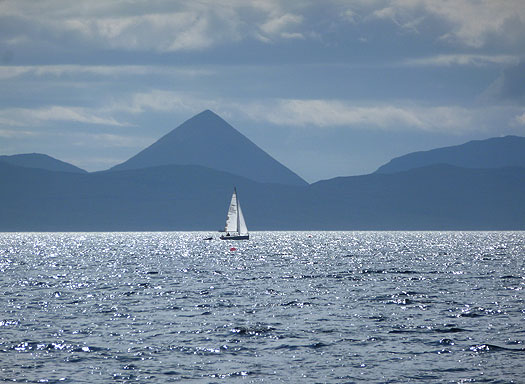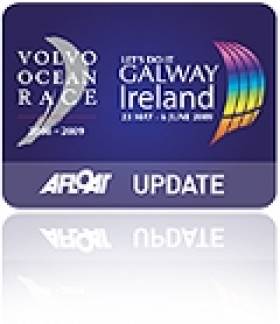Displaying items by tag: America's cup
The 34th America's Cup: Sailing's Sacred Monster Roars Again
#americascup – Today, the monster in its fully finished form finally emerges from its cave. For sure, we have a pretty good idea of what it will look like. Yet the convoluted preliminaries for 34th America's Cup have gone on for so long now that anyone who reckons they know what has been happening is probably deluded. And as for what it's really going to be like off San Francisco today, it's anyone's guess – curtain up on any show is a world away from dress rehearsal.
There's one heck of a difference between tests and trials, and defender and challenger selections. All we know is that two 72ft catamarans will be pushed to the limit, and the rest of the world will briefly pay attention to our sport of sailing, mainly in the hope of seeing a spectacular and very expensive crash before dinner.
But for sailing enthusiasts, mixed feelings only begins to describe it. Horrified and slightly guilty fascination is probably the most general reaction. Not to worry, folks. It has always been that way. The America's Cup is indeed sailing's sacred monster. But it's undoubtedly our monster. And it's just about the only way the general public connect with sailing. So we have to live with it with the best grace we can manage, for it's completely pointless trying to assert that it has nothing whatever to do with us.
It's grand guignol goes afloat. And it's the apogee of the times in which we live, for it's now way beyond the international. It's beyond the supra-national. It's globalisation par excellence. It may in theory be New Zealand challenging America. But the multiple-nationality mixes in the crews have made traditional concepts of sailing for your own country irrelevant. So it's completely appropriate that it's taking place in sailing waters off the world capital of electronic technological development in the American state which is home to the world headquarters of the entertainment industry.
If this all seems way over the top, worry not - be of good cheer. For just about every staging of the America's Cup has provided some of the most over-the-top events of its era. Larger than life characters. Spectacular and often dangerous maritime technology. And expenditure that does nothing whatever to reduce the popular perception that sailing is basically a rich man's sport.
All that together with all the jolly interaction of minutely detailed rule interpretation, legal rows and international incidents. The miracle is that so far nobody seems to have gone to war, but it's early days yet. Certainly back in the 1890s the disputes that our own Lord Dunraven got into with the New York Yacht Club weren't that far from the "send a gunboat" reaction which played a key role in international diplomacy at the time.

The schooner America shortly after her launching in New York in 1851. A swift and seamanlike vessel, she was able to sail across the Atlantic before winning the new Queen's Cup – subsequently the America's Cup - at Cowes that same year. A whole world away from today's hazard-laden 72ft catamarans, America survived a colourful life until 1945, when she was finally destroyed in a snowstorm in Annapolis .
Faced with all this, those of us who prefer the quiet life seek solace in contemplating the boats and the sailing, even if the last time the America's Cup was in a form to which ordinary sailing folk can relate was when it was staged off Perth in Western Australia in 1987. The racing was in 12 Metres with great sailing. This was thanks to the afternoon breeze wrongly known as the Fremantle doctor. It's actually the docker, from the days when it regularly brought becalmed sailing ships into port each afternoon. But it has been gentrified with suggestions of health benefits, as was Fremantle itself thanks to the America's Cup.
Whatever, it was a real racing series, using boats with which the world of sailing could identify. But after Dennis Conner won and took the trophy back to America, the short but happy period with 12 Metres came to an end, and since then we've had to get used to a new scenario each time round, sometimes with boat which are very odd indeed.
But then that's always been the case when we look at the America's Cup in its entirety. Recently, in talking here about Harry Donegan of Cork and his cutter Gull which he raced in the first Fastnet of 1925, we talked of Gull as having been designed by the young Charles E Nicholson, who went on to design some formidable racing craft, America's Cup boats among them.
In fact, it was Nicholson's first America's Cup challenge design, Shamrock IV of 1914 for Thomas Lipton, which was perhaps his most remarkable of all. The previous series of 1903 had seen things get out of hand entirely, with the Americans successfully defending with the 143ft Herreshoff-designed Reliance. She was lightly built out of such a toxic mixture of metals that it's said she hissed when put afloat, and after keeping the cup with three straight and convincing wins, she had to be dismantled as her seaworthiness could no longer be guaranteed.

Charles E Nicholson's hull design for the 110ft Shamrock IV in 1914 was very advanced for its time

Shamrock IV's rig was much more primitive than her hull design
The new rule for the proposed 1914 series saw boat sizes reduced, but for his first attempt Nicholson went high tech, producing a skimming dish 110ft long. Unfortunately for the challenge, the Great War broke out as this extraordinary boat was sailing across the Atlantic - challengers had to do this in the early days of the Amrica's Cup, as America herself had sailed to England in 1851. But when Shamrock reached New York, the series was postponed for the duration of the war, and when it finally took place in 1920, even though the Americans had had six years to create a faster boat, Shamrock IV came within one race of winning.

The hull lines of the J-Class Endeavour of 1934 were much less advanced in concept than the hull lines of Shamrock IV twenty years earlier.
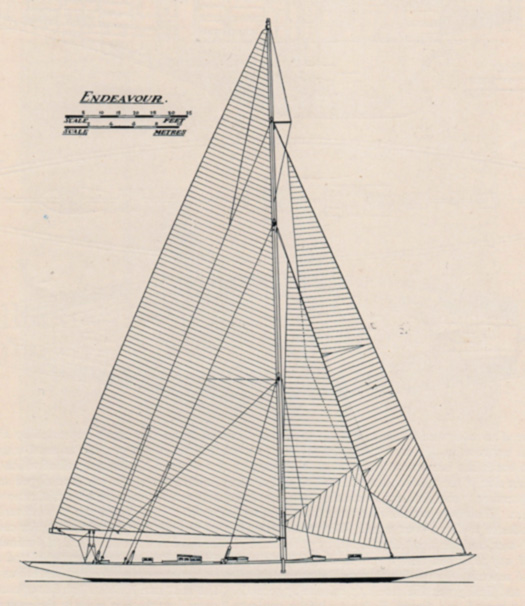
With the bow overhang longer than the stern, the J Class Endeavour is a rather odd-looking boat
Subsequently, Bermudan rig took over with the introduction of the J Class in 1930, but although the rigs were more modern, it could be argued that the J Class marked a distinctly retrograde step from Shamrock IV in hull design. I know they're continuing to build J Class yachts these days, but for the life of me I can't find them attractive. The sterns look all wrong, or maybe the bow overhang protrudes too much Whatever the reason, the J Class rule produces sterns which seem to rise too quickly, while the bow overhang is excessive to give a sort of back-to-front profile.
Thus a comparison between the hull lines of Shamrock IV and Endeavour – supposedly the most beautiful J Class of them all – shows a sweet hull in the case of Shamrock, yet with Endeavour you've a hull which is going to pull half the ocean behind her.
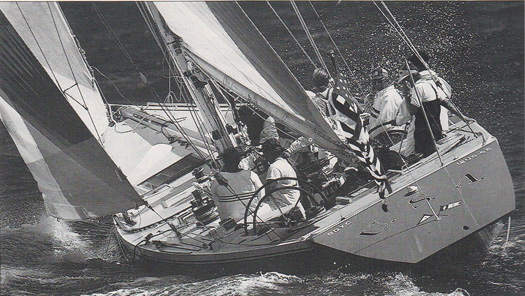
The great racing off Perth in 1987, when Dennis Conner's Stars & Stripes (pictured) wrested the cup back from the Australians. This was the last occasion in which the America's Cup was sailed in boats which bore some resemblance to normal yachts.
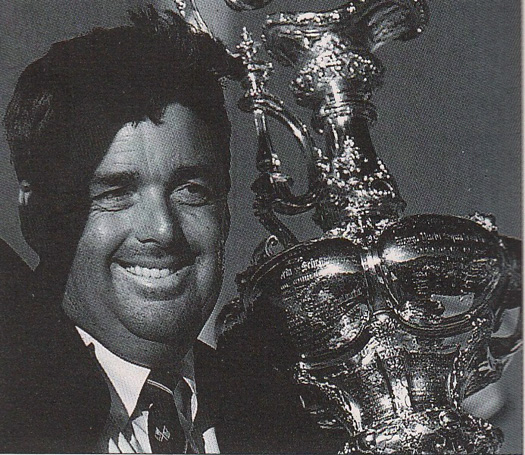
The Dennis Does It. Dennis Conner with the America's Cup after winning it back from the Australians in 1987.
It's all a long way from today's catamarans which aren't really described as boats at all – they're platforms underneath wings. And any disturbance of the water is minimal. So it could be argued that the only connection with the America's Cup in times past is that they're being sailed by people, but even there we have difficulty in discerning their humanity, as they're kitted out like bikers in the TT on the Isle of Man.
But somewhere in it all, there are real people. There isn't much Irish involvement this time round. But with names like William Henn and Lord Dunraven and Willie Jameson and Thomas Lipton and Harold Cudmore resonating down the years in America's Cup history, we cannot deny that slightly horrified fascination as the 34th series gets under way today in San Francisco.
Not least of the fascination lies in seeing what happens afterwards. We aren't talking about everyday ordinary folk here. The kind of hyper-successful people who get to make America's Cup challenges and defences genuinely do believe that when something goes wrong, then it undoubtedly is somebody else's fault. Their code is summed in this spin on an old piece of verse:
And when that one great scorer comes,
To write against your name,
He writes not that you won or lost,
But how you spread the blame.
Crew Bans, Points Loss For Oracle In America's Cup Cheating Scandal
#AmericasCup - The America's Cup has been rocked by news of a cheating scandal in Oracle Team USA that has seen the team docked two points and three of its members banned from the event.
According to Reuters, the penalties are "unprecedented" in the 162-year history of the America's Cup.
It emerged that one-class 45ft catamarans that the team raced in a preliminary event in July, and again in a youth race last week, had weighted bags with lead and resin stuffed into their frames.
Though the team's skippers and managers claimed no prior knowledge, and argued that no advantage had been gained from the illegal ballast, the international jury investigating the incident decided that points should be docked from the main 72ft boat racing division.
It also banned from the race crew members Dirk de Ridder and two other shore crew, while a fourth sailor was suspended for the first four races of the series.
Reuters has much more on the story HERE.
#AmericasCup – The Swedish Artemis Racing AC72 catamaran has capsized during training in San Francisco Bay and has suffered severe damage.
At least one crew member from the chllenger of record is reported to be seriously injured and receiving CPR. Local media reports also say not all crew are yet accounted for.
The boat is reported to be a total loss and support boats including the Coast guard are on scene dealing with the rescue of crew members and wreckage from the upturned craft. Tugs are responding to Artemis AC72 wreck, just north of Treasure Island.
Emergency crews were on site and performing CPR to a crew member who had been trapped under the platform of the yacht for an estimated 10 minutes according to an America's Cup news source.
A live video link of rescue efforts from CBS here
Artemis Racing is a professional sailing team challenging for the 34th America's Cup.
Artemis Racing is competing in the America's Cup World Series, the Extreme Sailing Series and on the RC44 Championship Tour.
The team represents the Royal Swedish Yacht Club (KSSS)
No official statement yet. Updates as we have them.
Tributes Paid to Swedish Yachting Legend Magnus Olsson
#VOR - The sailing world has paid tribute to Volvo Ocean Race coach and round-the-world yachting legend Magnus Olsson, who has passed away from a stroke at the age of 64.
Olsson was a long-time veteran of the Volvo Ocean Race (VOR), beginning in 1985 when it was known as the Whitbread Round The World Race and last competing in the 2008-09 edition.
Most recently he was coaching the all-women Team SCA in their preparations for the 12th edition of the race starting this summer.
"It's with great sadness I received the news about Magnus passing away," said VOR chief Knut Frostad. "He was my mentor when I sailed around the world with him 20 years ago.
"He was the inspiration for me and for so many more and more than anything he was the smile of the race," he continued. "A true friend has left on his final leg and the sailing world will never be the same without Magnus and his smile. Never. My thoughts are with his two sons and his close family today."
Olsson - known to friends as 'Mange' - was born on 4 January 1949 and grew up near Stockholm. He began sailing on Lake Mälaren aged eight and learned his trade in OK Dinghy, Trapez and 505s, winning three Swedish national titles in the latter.
Before beginning his round-the-world career he also served as crew on Sverige in the 1976 America's Cup.
The Volvo Ocean Race website has further tributes from world sailing luminaries HERE.
America's Cup Could Cost San Francisco's Taxpayers
#AmericasCup - The America's Cup could cost the city of San Francisco up to $20 million, according to Phillip Matier and Andrew Ross in the San Francisco Chronicle.
The columnists reckon that fundraising efforts to raise the close to $34 million needed to cover the event's expenses "have pretty much hit the wall at $14 million" - leaving an already cash-strapped city to potentially pick up the shortfall.
San Francisco's fundraising issues have echoes of Galway's hosting of the Volvo Ocean Race last year - an event that was a rousing success itself, but one that left race organisers in debt by nearly half a million euro.
Afloat.ie's own WM Nixon wrote at the weekend that "it's time for a reality check" for San Francisco with some notes to go before the first yachts race in the bay.
While he believes that the event will be a sell-out, "it's not a question of whether or not the tickets sell out. Rather, it's a matte roof how quickly, and to whom, and for how much."
Sails and the City
#americascup – It's time for the reality check in San Francisco. This morning, season tickets guaranteeing "the best seats on the bay" for the America's Cup 2013 go on sale. The America's Cup Season Pass includes a ticket to the choicest seating in a prime waterfront location at the America's Cup Village, with an elevated close-up view of the race start and the top turning marks of the course.
Perhaps talk of a "reality check" is pitching it too high. They'll sell out, as did the tickets to the same locations for the preliminary on-the-water sparring during 2012. But for those running the project, whether directly involved in everything to do with the sailing, or in the background co-ordination of the city's participation, each and every last pointer to the marketability of the ultimate sailing event is going to be closely analysed. The hope will be that conclusions can be drawn as to whether or not it's possible to generate enough interest in viewable sailing to make waterfront communities get more committed to it at official level.
So it's not a question of whether or not the tickets sell out. Rather, it's a matter of how quickly, and to whom, and for how much. The economic interaction between sailing and cities is extremely difficult to quantify, so the goldfish bowl which is the America's Cup in the Bay City will provide an excellent opportunity for gauging public interest, and where it all might go.
As it is, the city fathers in San Francisco are having quite a bumpy ride with the America's Cup. It took all sorts of negotiations and deal-making to secure civic backing to let the big sailing circus happen in the bay in the first place. Since then, a public appeal to build up a $20 million non-profit organisation to underpin the staging of major sporting events in the city, starting with the America's Cup, has been greeted mainly by silence – and it's not the agreeable silence of hundred dollar notes floating into plastic buckets.
San Francisco mayor Ed Lee is still in the early stages of creating this promotional organization, called OneSF, but if the America's Cup fails to hit its earning expectations, the hope of attracting events like the Superbowl in the near future will be severely hampered.
Coming as it does in the week when the Volvo Ocean Race organisation confirmed the list of ports round the world which will be hosting its stopovers in the next staging of the circumnavigation, it's of special interest. We're now getting a plethora of information as to which cities are hitting the target. But other than that they all want to do it, it's difficult to discern a shared pattern for success.
And when you add the complexities of big city politics, it can be anybody's guess as to what makes for the magic formula. But for the Volvo stopover wannabees, I'd suggest that being the finishing port is not a winning proposition. This seems to have been underlined by Galway's two experiences with the race. The first time round when Galway was a stopover, admittedly it was still something of a novelty, and we weren't stony broke. But the fact that there was still racing to be done gave it a special dynamic.
Second time round, you'd have thought Galway being the finish port would have done the business, but precious little business was done. The buzz wasn't the same. The national economic situation was dire and the weather was crap, and today the unhappy legacy of ill feeling still lingers on. There was no strong sense of the city, apart from the immediate harbour area, benefiting in any way.
There have been all sorts of explanations. In the economic extremities of the time, it's even possible that Ireland's new road system played a part. The Dublin to Galway motorway was unfinished for the first Volvo visit. But it was very much up and running the second time round. Thus economically stressed families in the capital could contemplate a day visit to Galway and get all of the excitement of the Volvo Ocean Race show without spending a cent in the western city, and still be comfortably home that same night. All they needed was a tankful of diesel for the people carrier, and enough cash for the road tolls. Crazy theory maybe, but who knows.....
By the same token, the Tall Ships in Dublin at the end of August was a gift for financially-stretched families. So much of it was just one great big free show, and though there was one day of awful weather, the rest of it had as good weather as the summer of 2012 could provide. So the citizens were happy with their free maritime show. And a happy citizen is a happy voter, so the city fathers were happy. But whether or not the traders were happy is another matter, though heaven knows those on the quaysides charged enough for snacks which would have been half the price in a normal retail outlet.
Yet for those who party, it was a marvellous excuse for a party. There are times when the sailing events into which we all put so much thought and effort in order to chime with public interest are simply seen by Joe Public as no more than a good excuse for a party. And when it's not convenient to party, interest is zero. One setting where you'd think sailing and public interest would comfortably interact is during Cork Week, when the fleets on the in-harbour courses are racing in dramatic style close in on the Cobh waterfront. It's so good you'd think they could sell tickets to those who want to watch. But in truth there are probably more people on the boats admiring Cobh than there are people ashore in Cobh bothering to look out at the racing.
I'd a telling insight on general interest in sailing at Wicklow during the start of the Round Ireland Race in June. While there was the usual crowded buzz around the harbour and Wicklow SC, I reckoned a better overview could be had up the road at Wicklow Golf Club.
Well, it hit the spot perfectly. So perfectly, in fact, that when the good times return, if you happen to be involved in organizing some sort of corporate function associated with the start of the Round Ireland Race, then see if you can cut a deal with the golf club. They've a bit of space, and there's a splendid view of the entire starting area and the first mile or so of the race itself.
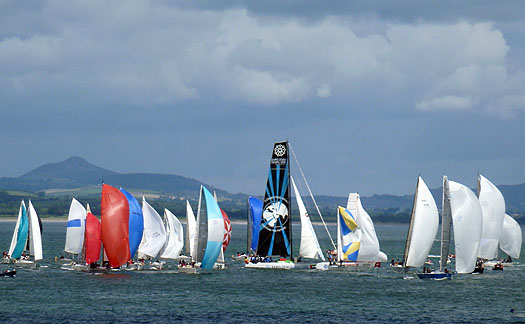
The start of the Round Ireland Race 2012 as seen from the clifftop tee at Wicklow Golf Club Photo: W M Nixon
Best view of all is at the tee which is right on the clifftop. There happened to be a four ball driving off as the last minute ticked away to the start. It took me a bit of overuse of the zoom lens to get a pic, yet it still made a double-page spread for the Afloat Annual. But as for the four happy golfers who could have enjoyed the best view possible of the start of the Round Ireland Race – they didn't take a blind bit of notice. When people bang on about making sailing accessible and visible to all, I sometimes think of those golfers. But maybe that's not quite fair. Golfers are a different species. If there'd been a golf course on Cape Trafalgar on the 21st October 1805, I don't think anyone playing on it would have noticed anything at all unusual out at sea on that particular day.
DERRYNANE STAYS IN BUSINESS
Derrynane in far southwest Kerry must be Ireland's most complete cruising anchorage. It's utterly beautiful, it provides perfect natural shelter, its feeling of being away from it all is total, and ashore there's everything you could want, from superb beaches and glorious walks, to a perfect pub nearby.

Derrynane, probably the most complete cruising anchorage in Ireland. Photo: W M Nixon
But that's only the start of it. The place is suffused in history and topical interest. It's the home port of Damian Foxall, and in times past it was the summer sailing base for Conor O'Brien of Saoirse fame, whose signature you can see in the guest book at Keating's pub. And the Dunraven family of America's Cup notoriety also had their summer place at Derrynane.
Before that again, it was of course the ancestral home of Daniel O'Connell, The Liberator, and a run ashore would be given added depth with a visit to his family's Derrynane House, which has been entrusted to the nation since 1964. Despite its setting near the sea, it slumbers in an almost tropical torpor, an architectural mishmash of considerable charm. And for sailing folk, it has added interest in that O'Connell was himself a sailing enthusiast, co-founder of the Royal Western YC at Kilrush in 1829, and one of those who re-started the Royal Irish YC on 4th July 1846.

Ancestral home of a sailing man. Derrynane House is "an architectural mishmash of considerable charm"
A week ago, however, it was announced that Derrynane House would be closed for six months from April 2013 for a major re-furbishment on which €1.2 million would be spent. I marked it down as an item of information to be included this week for anyone cruising the southwest who would normally plan a visit to Derrynane and the house in their programme. But the good people of the neighbourhood, many of whom are involved in the hospitality industry, have decided otherwise.
Righteous indignation is a marvellous energizer, particularly when it is genuinely righteous. When you think of it, of course, there is nothing more absurd than planning to close the jewel for visitors in the neighbourhood crown right in the middle of the year of The Gathering. Whatever, the quiet roar of righteous indignation from the people of Derrynane and Caherdaniel blew away all the nonsense of closure this summer, and the re-furbishment is being re-planned to happen outside the summer season.
If the re-furbishment programme is being re-structured, maybe they can expand it to include a major tidy-up of the ancestral graveyard down by the harbour. Things may have improved in it recently, but I was there last Easter, and it was in a disgraceful condition.
SHACKLETON IS SOMETHING ELSE
Those who re-create the astonishing 800 mile voyage by Ernest Shackleton and his men in the sailing lifeboat James Caird from Elephant Island to South Georgia have tended to add even further to the lustre of Shackleton and his shipmates. Their voyages have usually been in the Antarctic summer, whereas the original epic passage took place in late April and early May, which would have been the equivalent of undertaking a major Arctic voyage in the 22ft boat at the beginning of November.
Thus the recent successful Caird voyage by Tim Jarvis and his shipmates is the same as an Arctic voyage at the end of July. But that is still a great achievement by most standards. It's just that Shackleton's voyage was so far beyond our comprehension that we needs must grasp at anything which will put it in context.
He and his shipmates were superhuman, and none more so than Tom Crean. Even the most casual study of life aboard shows that Crean was central to the survival of all. Anyone who has ever tried to heat a cup of coffee in heavy weather on a comfortable cruising boat at sea will have some appreciation of Tom Crean's efforts in ensuring that everyone on board the tiny vessel had one life-saving mug of hot milk every night.
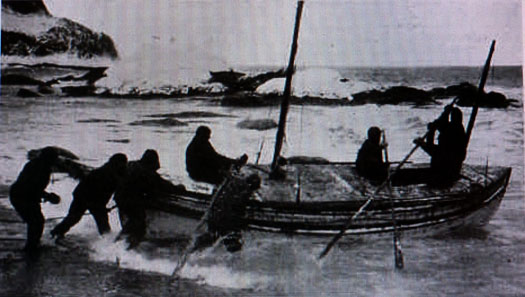
Not yachting as we know it...Ernest Shackleton and his crew launch the tiny James Caird at Elephant Island as the Antarctic winter starts to set in on April 24th 1916.
It's absurd to compare the superhuman task of heating milk aboard the James Caird with your average yotty's heavy weather experiences, but as it happens, in a sense this was a yachting venture which happens to chime with something done by Conor O'Brien from our Derrynane story.
After he returned with his Baltimore-built Saoirse from his circumnavigation in 1923-25, Conor O'Brien received an order from the Falkland Islands company for a larger version which would become the inter-islands trading ketch Ilen. Ilen was built in Baltimore (she's back there now, being restored at Oldcourt) and in 1927 O'Brien was to sail her out to the Falklands. But the only way he could get insurance was if she was registered as a yacht, so it was Ilen RIYC, complete with burgee, which sailed to the south Atlantic.
With Ernest Shackleton and the Endurance, while everyone wanted him to sail under the white ensign as befitted a national hero who should have been part of the Royal Navy, there were technical objections. But it was neatly solved by Shackleton becoming a member of the Royal Yacht Squadron and Endurance went to Antarctica as a yacht of the RYS, entitled thereby to fly the white ensign.
NAOMH BAIRBRE RUMBLES ON
There is only one thing more boring than a sailing boat under motor, and that is a sailing boat under motor in the rain. But we had a lot of that on Thursday night on TG4's Turas Huiceara, the six part series on Thursdays at 9.30pm which traces the voyage of the 47ft Galway hooker Naomh Bairbre along the Celtic seaways to the north of Scotland and back to Connemara.
Last week we'd left Donncha and the lads in Castlebay in Barra with a double whammy. Their main boom – all 34ft of it – had broken. And in TG4 HQ somebody had forgotten to switch on the sub-titles button, which as Donnacha mentioned in his response here on Monday, had baffled everyone – apparently even some fluent Irish speakers were having difficulty understanding the Barra Gaelic.
Not all, though. Anyone who polished up their Irish in the Gweedore Gaeltacht in Donegal would have had no problem. Many years ago I was out in Barra with Johnny Roche in his South Coast One Design Safina (super little boat, she's based in Poolbeg these days, owned by John B Kearney's nephew) and one of our crew was Denis Drum, purveyor of fine art to the gentry, and world class chef. Denis noted the little fishing boats landing lobster and crab in abundance, and decided to get some, but the guys in the pub told him the story that all the catches go straight to Paris for the highest prices, and that he'd no chance.
Nothing daunted, Denis went down and turned on the old charm, but no success. So he switched on his Irish sub-titles button, waxing lyrical with the old tongue he'd learnt in Gweedore. It was magic. He was given as much shellfish as we could possibly need, and more, and all for free. There was so much that a cockpit locker lid had to be used for the serving dish. We were up to our ears in lobster and crab for several days. So Barra-speak can be understood in Ireland.
But not by most of us, and maybe it's just as well. I've since seen the programme on the TG4 Player with the sub-titles, and Calum MacNeil's story of the MacNeils of Barra and their interaction with the home of their ancestors was not a a pretty yarn. Seems the MacNeils of Barra became experts in seaborn cattle raiding to the land of the O'Neills, and their speciality was sweeping into Clew Bay on Reek Sunday and grabbing the cattle while all the locals were on top of Croagh Patrick for the annual pilgrimage. It must have been someone connected to the MacNeils who made sure that sub-title button was switched off.
Well, anyway, this past Thursday, still without their mainboom they had to motor all the way in order to visit St Kilda. Fair play to Steve Mulkerrins who built the Naomh Bairbre in Chicago in 2003-2006, he made a good job of installing the auxiliary engine, because the big girl did it all without a bother, but it would have made for much better television if it had been under sail.
That said, the film gave an excellent impression of the utter remoteness of St Kilda, and its inherent sadness. But by this time the rain was set in, and they seemed to have it with them all the way back in to Skye for the Highland Games, where the caber wasn't big enough to be a new mainboom (the average caber is "only" 19ft 6ins).
Cruising off Skye in sunshine in August 2012. But the Naomh Bairbre wasn't so fortunate – in Skye she found neither sunshine, nor a new mainboom. Photo: W M Nixon
So they went north to Stornoway where a lovely man felled a fine Sitka spruce in the woods beside the castle and hallelulia, Naomh Bairbre is sailing again. Next Thursday they get round the north of Scotland (we'll need some convincing that there's much of Gaelic interest on the south shore of the Pentland Firth), and then start heading back towards Ireland through the Caledonian Canal, hopefully finding some sunshine on the way. There was little enough of it last Thursday night, and in February it's as welcome as a glass of cool water in the desert.
Comment on this story?
Leave a message in the box below or email William Nixon on [email protected]
The America's Cup – Sailing's Sacred Monster
#americascup – The America's Cup is a sacred monster, hellbent on devouring its own followers. That is part of its awful fascination. You play with fire if you get involved with this "greatest" of sailing's sporting challenges. Either you succeed in using it for your own purposes, or it uses you and dumps you afterwards. No-one, but no-one, goes through the experience unmarked.
Its history includes a litany of personal tragedies such as suicide, bankruptcy and jail. And major international diplomatic rows for good measure. Entire reputations are won and lost with it. Yet once again, here it is, 2013 and an America's Cup Year. Like it or lump it, this is the tops. The America's Cup is the peak of our sport. Alas.
We only have to look at the history of Irish involvement to get the flavour of it. First one into the fire in 1886 was William Henn, whose family owned property in County Clare and lived in Paradise House on the estuary of the Fergus River southwest of Ennis. Henn challenged with Galatea, a large (102ft) comfortable performance cruiser, designed by Beavor Webb who'd been born in Enniskillen.
Seagoing comfort was a good idea in those early days of challenging, as the defending Americans insisted the challenging yachts should sail on their own bottoms across the Atlantic, just as the America herself had sailed to Europe in 1851. But Galatea was outsailed in light winds for the Cup races. So the gallant Lieutenant Henn and his supportive wife and their ship's company (including Peggy the pet monkey) stayed in America and lived aboard the Galatea in the hope of stronger winds for another challenge the following spring. They lost those races as well, but their winter presence in America had fascinated the rapidly developing newspaper industry, and reinforced the tendency where the people involved, their private lives, and the source of their funding, is of as much public interest in the America's Cup as the yachts and sport itself.
It's said that the remains of Galatea can still be discerned in the Fergus Estuary – certainly Conor O'Brien, another Shannon Estuary sailor, mentioned her as being anchored off Paradise House. The house itself is now a derelict overgrown shell, and the Henn family is long gone from County Clare.
Thereafter, America's Cup challenges became much more professional and inevitably controversial, and none more so than with Lord Dunraven from the other side of the Shannon Estuary, at Adare in County Limerick. His first challenge in 1893 used the G L Watson-designed Valkyrie II (117ft), but as this was the first time Nathanael Herreshoff had designed the defender, the peformance stakes were much raised, and Valkrie II suffered three straight defeats.
But Dunraven had got a taste for it, and though enormously wealthy (an ancestor had married a Welsh heiress whose property included several fields, all of them coalfields), he got together a syndicate of wealthy people, mostly Irish landowners, to support him in challenging again in 1895 with the new Valkyrie III.
This time round, public interest reached an all-time high, and Dunraven protested that the presence of large spectator steamers had hampered his boat's performance. Things got really nasty, the problem was never really resolved, the lawyers were busy, Dunraven was turfed out of his membership of the New York Yacht Club (an unprecedented event), and it all ended in tears.
Down the years, Lord Dunraven is remembered only as the prickly little aristocrat who got into an international row as a consequence of the America's Cup. It's true, but it's unfair. He was a man of prodigious energy, something of an inventor, and an enlightened landowner and employer. Despite the unpleasantness in America, he was remarkably successful in political negotiation and working towards agreement, although he was never a fulltime politician.
In 1902 he chaired the conference in Ireland which resulted in the establishment of the Land Commission, and thereby ended the Land League wars. It was a pivotal achievement in Irish history.
The shape of modern Irish agricultural life and the type and size of farms we have to underpin our rural society today is in part due to the patience, diligence, skill and understanding of Windham Thomas Wyndham-Quin, fourth Earl of Dunraven. Yet all he is remembered for is his troubles with the America's Cup.
Those troubles in turn saw his syndicate members distance themselves. Only thanks to the new Martin Black book on G L Watson do we now know that people like the McCalmonts of Mount Juliet in Kilkenny were financial supporters of the Valkyrie III challenge. But by this time it was big business, and with the unpleasantness left by the Valkyrie III affair, the way was open for a new challenger to bring peace and sportsmanship to the fore.
It tells us much about the good sense of John Jameson, the most successful owner of large racing yachts in Ireland in the late 19th Century, that he turned down all blandishments to get involved in the America's Cup circus. But then came Thomas Lipton, "the man who invented himself". From humble origins in Monaghan, rising through shops in Glasgow which became an expanding international retail empire, he saw the America's Cup as an opportunity, an attractive sporting challenge in which he could gain favourable publicity for the Lipton brand on both sides of the Atlantic.
Though all seemed bonhomie and good sportsmanship, Lipton could be quite ruthless in putting his five campaigns together, even though, in the end, none was successful You needed a recognized yacht club through which to challenge, so having failed to join the Royal Yacht Squadron through being in trade and because of his humble origins, as a Monaghan man he turned to the Royal Ulster Yacht Club in Belfast, who elected him with acclaim. But until then, the RUYC had got by without a clubhouse, though they had a starting battery in Bangor. Lipton insisted he needed a club with a clubhouse, so 30 of the 130 total membership of the RUYC divvied up to build a complete new clubhouse in Bangor in jig time, and it was finished in April 1899.
With hindsight, we can see that for the RUYC, the America's Cup challenge was the cuckoo in the nest. Already, some of the keenest sailing members had moved away to join a new club further up the lough, which soon became the Royal North of Ireland YC at Cultra. Meanwhile, the energies of the best administrators back in RUYC were being taken up with Lipton's first three challenges – in 1899, 1901 and 1903. Other forms of sailing were very definitely second fiddle in RUYC. Yet we now know that Lipton was not in the least grateful. It is said that he was only once in the fine new clubhouse built at his behest, though doubtless they'd have seen more of him if he'd won and the RUYC was defending. But as for his loyalty to RUYC, it was very flexible – we now know that in 1904 he was preparing another challenge through his new VBFs, the Royal Irish Yacht Club in Dun Laoghaire.
That failed to go ahead only because the design rules for the challenge could not be agreed between Lipton and the New York YC, and for his remaining two challenges in 1914-19 (war intervened), and 1931, Lipton returned to RUYC. He never did win the cup, though Shamrock IV could well have done it had the series gone ahead as planned in 1914 before the outbreak of the Great War. But his genial sportsmanship, sometimes a skilled act, worked well to gain favourable publicity for his retail business interests.
Direct Irish interest therefore ended in 1931, though in 1983 Cork's finest, Harold Cudmore, played a key role in the historic wresting of the Cup from the Americans after they'd held it for 132 years. John Bertrand helming the 12 Metre Australia II had the slightly faster boat, but defender Dennis Conner with Liberty was the more skilled helmsman-tactician, and this was most evident at the starts. The Australians called for a lay day, as they were entitled to, and provided Cudmore with a 12 Metre to go out and put the Bertrand/Australia II combo through a gruelling day of start training off Newport. In the best of seven series, the Americans had already won the first two races, but now Australia II clawed her way back with Bertrand's improved confidence at the starts. It was then the Americans who called for a lay day, and in all the series ran for 14 tense days until, on Monday September 26th 1983, America lost the America's Cup by 4 races to 3 after a neck and neck final race.
Dennis Conner then won the trophy back in one of the finest America's Cup series of all, off Perth, Western Australia in 1987. Subsequently, the highest level of Irish interest came through Michael Fay's New Zealand challenges which were made by someone who was proud to proclaim his Irish lineage at every opportunity. But the America's Cup has been won and lost and won again and lost again, almost despite other events of global concern. Wars have been fought, empires have fallen, fortunes have been made and lost, great crimes have been committed, man has walked on the Moon, and new forms of sailing have come to the fore. Yet despite the world in general and the world of sailing in particular changing out of all recognition, some 162 years after a fine schooner won a race around the Isle of Wight, the America's Cup is more than ever the peak of sailing. It defines the lives of all those involved with it, and as summer draws on we will all look with increasing and sometimes horrified fascination towards San Francisco and an epic battle between incredible 72ft catamarans raced at unbelievable cost.
RIOT ON REE
We had The Raid up the Erne and down the Shannon last September. Now we have the RIOT round Lough Ree and down the Shannon to Lough Derg, set for the last week of June this year.
RIOT is Round Ireland On The Inside. The inside is Lough Ree, beside which you can find the pillar marking exact centre of Ireland. It was put up by some Victorian worthies in Westmeath who had little enough to do with their time except work out sums, and calculate through a weird formula the location of the exact centre of the Emerald Isle. Putting up a pillar made it official, and good luck to them for doing so. That said, it might be interesting to use today's computers to see just how accurate they were.
But there's no rush to do so, and there has been no rush in promoting the idea of the Round Ireland On The Inside Race either. Alan Algeo has had the idea for a very long time. I can remember it being discussed at length (and towards no immediate conclusion) when were cruising Lough Ree back in 1998 on his 85ft barge Linquenda, in company with David Beattie's 47ft Dutch Lemsteraak Schollevaer.
Things have changed, however. Alan Algeo has now got his hands clamped firmly around the levers of power. He is Commodore of Lough Ree Yacht Club (founded 1770), and having already served one dutiful and awfully well-behaved year, he has earned the right to implement some of his own notions. Then too, he was one of the most enthusiastic participants in The Raid, sailing the 17 mile length of Lough Ree in a Shannon One Design in a minute or two over two hours, which is cooking with gas for sure, and gives him some right to suggest how much others should be able to achieve in the course of a day's sail.
Other factors are involved. The mighty Linquenda will be celebrating her Centenary. More of a ship than a barge, she was built as a heve-barge (a single-masted sailing vessel) in 1913 at Westervoort in order to serve as a hagenaar, that is plying the route to The Hague. She will make a superb mother-ship and committee boat for the RIOT, but there'll be more centenaries than that to observe, as the Schollevaer is also going to be marking her hundred years.
She'll have more than that to celebrate, for in the big freeze of 2010, one of her hull inlets split through ice pressure, and owner David Bettie returned to his waterside house on Lough Ree to see his beloved boat's mighty mast sticking up out of the icefloes, but with precious little else still visible. The restoration is ongoing, but we're assured Schollevaer will be there in prime order to mark a hundred years and a re-birth.
Another celebrant will be Dan O'Connor's fine motor-cruiser Harklow, marking her Golden Jubilee, as she was built for Douglas Heard by Jack Tyrrell of Arklow in 1963 to succeed Douglas's original inland cruiser, the converted lifeboat Hark with which he was the last skipper to pass through the Royal Canal in 1954, when it's eventual re-opening in 2010 would have been dismissed as a crazy dream. You will have guessed that Hark was Heard's Ark abbreviated, while the Harklow name acknowledged the Tyrrell input into the new boat using ideas learned from the old.
So the hope is there'll be more than enough in the way of big boats with lids and beds to provide hospitality for those on little boats with neither. Thus the RIOT really can undertake a series of extended passage races which will take the fleet right round Lough Ree in considerable detail and to many venues. Numbers will then be augmented come the weekend, with boats joining for the annual two day Shannon One Design Long Distance Race from Lough Ree down to Lough Derg, with an overnight at Banagher.
The details are still being finalized, but basically the RIOT starts with an informal assembling at Lough Ree YC in Athlone on the evening of Sunday 23rd June, and there's racing every day from Monday 24th June onwards, finishing at various places on the lake in a continuum, and getting back to LRYC on Friday June 28th.
Next day they race the first half of the Long Distance to Banagher, then it all winds up on Sunday June 30th at Lough Derg. Judging by the eclectic entry for The Raid, the RIOT will be of interest to boats of many types, indeed the fact that much of its is happening in Lough Ree will mean that keelboats can also be realistically involved. Lough Ree YC website is www.lryc.ie.
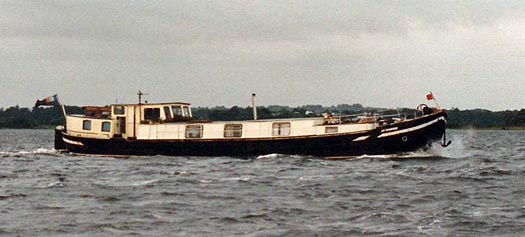
Lough Ree YC Commodore Alan Algeo's ship-like 85ft barge Linquenda will be celebrating her Centenary during the RIOT on Lough Ree at the end of June Photo: W M Nixon
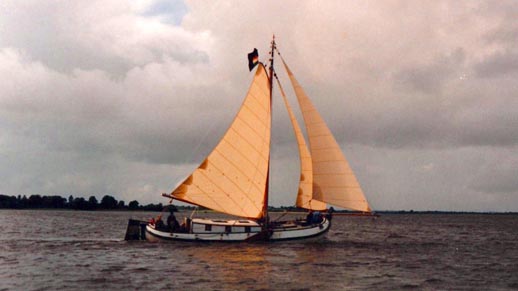
David Beattie's 47ft fully-rigged Lemsteraak Schollevaer has been restored, and will be sailing Lough Ree and the Shannon in June to celebrate her Centenary. Photo: W M Nixon
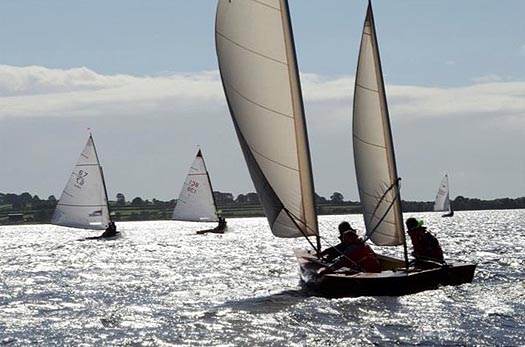
Two Shannon ODs and a ketch racing on Lough Ree in The Raid last September
BANKING ON AN ISLAND
Why on earth are people throwing up their hands in horror at the news that hundreds of thousands of tons of material extracted from tunneling in Dublin is going to be dumped about three miles out to sea just beyond the mouth of the bay? This isn't a problem. This is an opportunity.
It has long been obvious that the Leinster coast needs more islands. In watching Sean Cullen's fascinating presentation about the INFOMAR surveys in December at Poolbeg Y & BC, and in particular his computerized displays showing the details of Dublin Bay, it became immediately obvious that the Burford Bank is an island which is just waiting to happen.
Think of how much more interesting Dublin Bay would be with its own Sable Island stretching for a mile or two north-south out where the Burford is now awash, providing shelter and an anchorage and somewhere to see, and maybe even visit?
After all, it's not so long ago that the Bull Island simply didn't exist. Yet now, thanks to the limited technology of the 19th Century in building the North Bull Wall, there it is – the Bull Island is one of the most important, welcome and popular features of the entire bay.
So surely with 21st Century technology we can manage something, and further out in the bay at that. But before creating new islands, be mindful that Dublin Bay has lost at least one. There used to be a Clontarf Island, and you can still see the remains of a house that was reputedly on it when you turn right off the Alfie Byrne Road to go along the front of Clontarf towards Howth. It looks like the ribs of an old shipwreck, or even the framework of a wooden pier, but it's apparently the lower skeleton of the house still there, but the island long gone.
Clontarf Island was noted as a healthy place to be when Dublin was afflicted by plague, so in the 1830s a wooden summer house was built on it by a Dublin publican called Christopher Cromwell. He is said to have been a descendant of Oliver Cromwell, and no, I'm not making this up, but somebody else may well have done so once upon a time. Anyway, on the 9th October 1844 Christopher and his ten year old son William were overnighting out on their island, and a mighty storm came up and swept everything away, sadly including father and son – their bodies were found along the shore, while most of the house was splintered along the then-new Great Northern Railway embankment, which ran along the beach but is now well inland.
It may well be that the reclaiming of land along the East Wall road with the consequent narrowing of the Tolka Estuary meant the island was also being eroded by the river as well as the sea, but it is a fact that an island which was shown clearly on all maps until 1844 – and whose ownership was at times disputed – had simply disappeared after the massive Autumn storm of 1844.
So we should bear this in mind when planning to build Burford Island. But with the ready availability of the basic material thanks to all this stuff which is going to be tunneled soon in Dublin, some rapid planning is necessary before it is all wasted by being dribbled into the sea somewhere off the Baily.
The great yacht designer John B Kearney, in his day job as the de facto Harbour Engineer to Dublin Port, led the way in experimenting with screw-in piling to support the North Bull Lighthouse at the entrance to Dublin Port. It would be a fine memorial to him if we could use the Kearney technique to drive a couple of hundred giant corkscrews into the Burford Bank in order to hold the tunnel waste in place, and thereby allow a sandbank to build up just like the Bull Island above high water level.
With the creation and expansion of the Bull Island almost within living memory, we have a very accurate record of the sort of plants which thrive in island-building in Dublin Bay, and a repeat of this out at the Burford would be a wonderful exercise which would provide employment for many specialists, and also of course be a tourist attraction.
In no time at all we would have the new island well covered with tough marram grass. Soon after that we could experiment with easy-growing cordylines, as most people think they're palm trees, and who are we to teach them otherwise? For what we want is an island in place in jig time, and if it looks like vaguely like an island of the South Pacific, so much the better. In no time at all there'd be a golf course on it, and then a casino, and a hundred years hence people will want to keep it exactly as it has become, because by then it will be an important part of our heritage.
THE AMERICANS DO IT BIGGER
They don't necessarily do it better, but there's no doubt Americans do it bigger. Latest area of interest for them is in being top of the size pile is in semi-tame wild cetaceans.
For years now, ever since 1984 or thereabouts, Ireland has been something of a world leader in this very specialised field with Fungie of Dingle. He (or she) is undoubtedly a wild creature, the essence of freedom, yet Fungie chooses to have such a close relationship with people, and particularly the boatmen of Dingle, that he/she can tell if one of the dolphin-watching boat drivers is in a gloomy mood.
So it really is something very special, particularly as Fungie is now quite some size. But Americans do it bigger. Much bigger. The word is there's a semi-tame fin whale in California which is showing unusual interest in boats and the people in them. He has stayed for some days now at Dana Point in southern Los Angeles, and has shown no sign of wanting to move on as all the rest of his group have done.
While he's not putting on displays like Fungie does, perhaps it's as well. The new Dana Point resident – they already call him Farley – is pushing towards 40 feet in length, and therefore chimes in at around a hundred tons. But he behaves in the playful manner of a much smaller creature, and his apparently genuine friendliness and fascination with boats and people is completely new to California's experienced whale watchers. There's an unusually high level of tasty krill in the area at the moment, so maybe the good food is putting Farley in a specially friendly mood, as he needs between three and four tons of krill a day. Whatever, he's definitely a bigger attraction than most of the movie stars in nearby Hollywood.
America's Cup 'Team Oracle' Catamaran Makes a Spectacular Capsize
#acws – A spectacular cartwheeling capsize from Team Oracle over the weekend was captured by the slick media operation in San Francisco for the America's Cup series. Although Orcale skipper Jimmy Spithill won the match race leg of the America's Cup World Series in 'Frisco yesterdayhe got no marks for this fantastic cartwheel.
#AMERICAS CUP - Moët & Chandon has signed on as an official sponsor of the 34th America's Cup.
The luxury drinks last week announced its parnership as the official champagne of the prestigious race, reinforcing its long-standing history of supporting sportsmanship, and sailing in particular.
Moët & Chandon will be following the world's fastest boats from the World Series to the Louis Vuitton Cup (4 July-1 September 2013) and the America's Cup Match in San Francisco from 7-22 September 2013.
As previously reported on Afloat.ie, the 34th America's Cup will effectively take place in a nautical stadium along the San Francisco waterfront, with spectators being able to follow the whole race from the shore.
Skippers from all nine teams competing in the America's Cup World Series were invited at the official announcement to sign a Golden Jerboam of Moët & Chandon. It will be auctioned with proceeds going to the Healthy Ocean Project, the global initiatives of the 34th America’s Cup to educate the world’s populations about the issues facing our oceans and inspire them to act.
Among those sailors stepping up to the America's Cup challenge is Cork native Revelin Minihane, who has joined ORACLE Racing's team for its World Series campaign.
As a junior, Revelin Minihane was a Mirror world champion crewing for Marty Moloney in 1999, and is yet another example of some of our top juniors making it on to the world stage.
Minihane's pedigree in a safety role - which has taken on added importance with the new wingsail catamarans - is also undoubted, with his experience volunteering with the Baltimore RNLI lifeboat.
VOR Skipper Cammas Receives French Sporting Honour
Volvo Ocean Race skipper Franck Cammas has been presented with one of France’s most prestigious sporting honours.
The man in charge of the Groupama sailing team was awarded the Grand Prix de l’Académie des Sports in Paris recently, recognising his achievements in sailing in 2010.
These included his skippering of the 100ft trimaran Groupama 3 non-stop around the world in a record-breaking in 48 days, 7 hours, 44 minutes and 52 seconds.
Cammas is only the fifth sailor to be presented with the award, following Whitbread Round the World Race skipper Eric Tabarly, 1983 America’s Cup winner John Bertrand, solo sailor Isabelle Autissier and Alinghi team principal Ernesto Bertarelli.
But Cammas isn't resting on his laurels, as he's currently preparing with his team to compete in the next Volvo Ocean Race kicking off next month.
He will lead a crew of 11 sailors - including Kerryman Damian Foxall - on the 70ft monohull Volvo Open 70 Groupama 4 in the 39,000 nautical mile race, which is set to conclude in Galway next summer and will also involve Wexford sailor Justin Slattery, who is in the crew for Team Abu Dhabi.
The action starts in Alicante, Spain on 29 October with the first in-port race. The first leg to Cape Town then begins on 5 November.
































